Many people who live with bunions experience only minor foot pain. But in other cases, hallux valgus leads to a foot deformity and severe pain, making it extremely difficult to walk. Before taking the surgical route, our podiatrists in New York, considers various conservative treatments. In case bunions cause severe pain and conservative treatments were to no avail, surgery might be the only effective treatment.
Visit our bunion treatment center and meet Our Podiatrists, the top bunionectomy doctors, and bunion surgeons. Our podiatrists have the experience, skill, knowledge, and compassion to accurately diagnose and effectively treat your foot disorder. Get the bunion treatment you need in the safe, reassuring hands of the best bunion surgery specialists.
After bunion surgery, you can expect:
- Pain relief
- Improvement in the stability of the foot
- Improvement in the appearance of the foot
- Ability to walk normally again
- Prevention of the development of claw toes or hammer toes
Quick links:
- What Is Bunion Surgery?
- Bunion Surgery Before and After
- Am I the Right Candidate?
- What Are My Bunion Surgery Options?
- What Does Surgical Bunion Correction Entail?
- What Should I Expect After Surgery?
- What Are the Potential Risks?
- When Can I Return to My Daily Activities?
- Published Data
- How Painful Is Bunion Surgery?
- How Much Is Bunion Surgery?
- Is Bunion Surgery Covered by Insurance?
What Is Bunion Surgery?
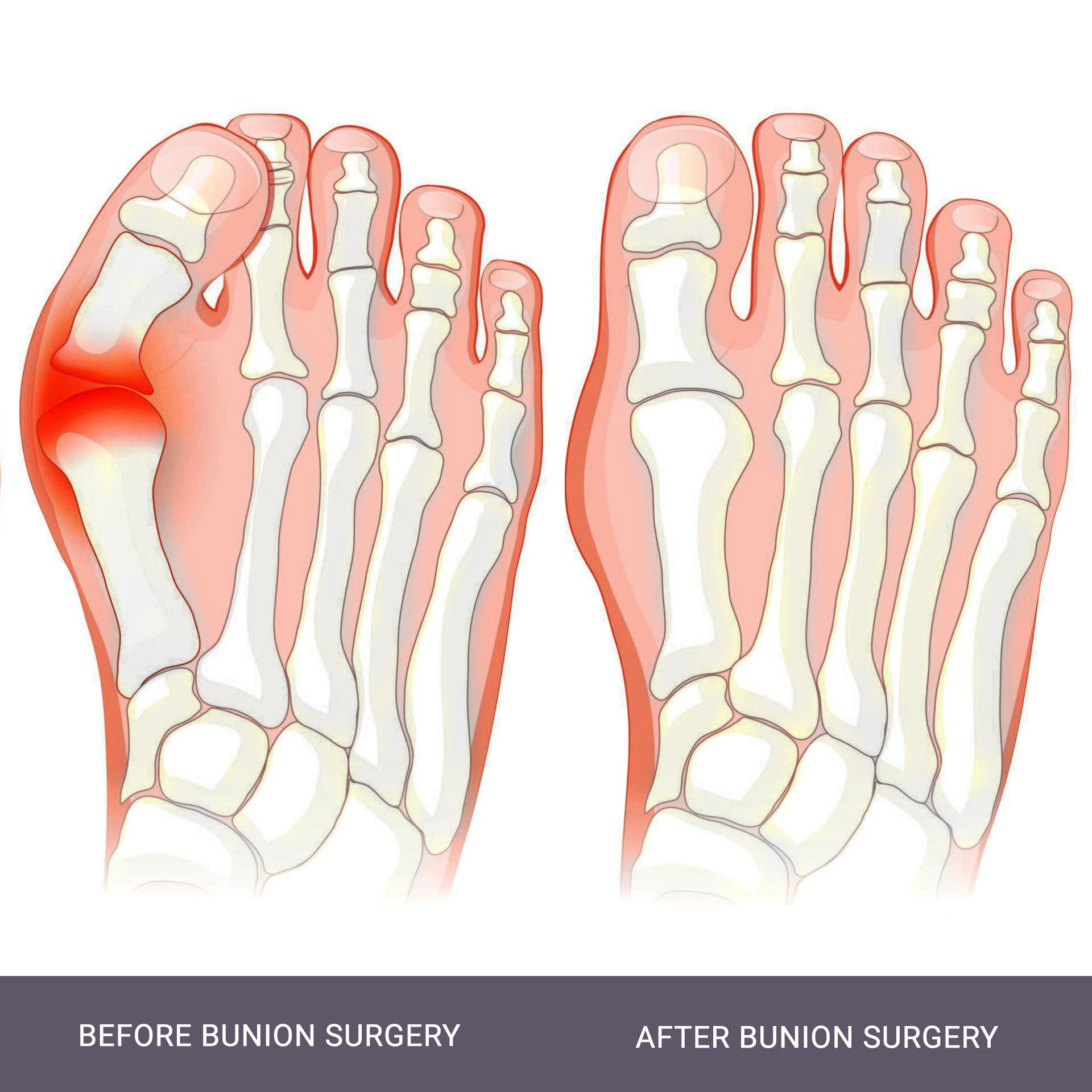 Bunion surgery, also known as bunionectomy, is probably the most effective treatment for forefoot deformity. The main goal of the procedure is to relieve pain and reduce discomfort during your walking cycle or other daily activities.
Bunion surgery, also known as bunionectomy, is probably the most effective treatment for forefoot deformity. The main goal of the procedure is to relieve pain and reduce discomfort during your walking cycle or other daily activities.
Before deciding on the most appropriate type of surgery, Our Podiatrists meticulously assesses various factors, such as how far the position of the bones in the foot has changed. Often people have a bunion deformity on both feet, and correcting both deformities at the same time is referred to as a bilateral bunionectomy. We recommend correcting the deformity one foot at a time, but in some instances, bilateral bunion surgery may be indicated. Visit Our Podiatrists, the best-rated bunion removal doctors, to explore your surgical and non-surgical treatment options.
All symptoms, potential procedural bunion removal options should always be discussed with your local podiatrist or bunion surgeon after a thorough consultation and examination for an accurate diagnosis and treatment plan.
Purpose of Bunion Correction Surgery
Bunion surgery is only performed when conservative, non-surgical solutions don’t alleviate your pain. Some of these conventional solutions include:
- Switching to properly fitting and wider shoes
- Placing padding on your toe
- Taking anti-inflammatory medicine
- Wearing orthotics
Bunions can cause your big toe to move towards the second toe, which over time can create a painful deformity. This can make it very hard for you to find comfortably fitting shoes. Your bunion doctor can explain the cause of your bunion and recommend the best bunion treatment.
By the time you visit a bunion surgeon, you may have exhausted conservative measures and are already considering minimally invasive bunion removal surgery.
It is important to not rush into surgical correction without a thorough workup with our Podiatrists who will recommend a customized solution to your problem. A podiatrist can diagnose your condition and tell you if minimal incision bunion surgery is a good option.
Symptoms that may indicate the need for minimally invasive bunion surgery include:
- Intense pain
- A decrease in toe mobility
- Severe deformity of your foot
- An inability to fit your foot into your shoe
- A “crackling” sound in your toe as it moves
You need to provide your complete medical history to your bunion surgeon, as well as if the deformity runs in the family. X-rays are typically part of your bunion work up allowing the bunion removal podiatrist to measure the extent of deformity as well as the correction needed for optimal surgical success. Your bunion surgeon will choose a procedure that corrects your deformity with minimal scarring and recovery time.
Bunion Surgery Before and After
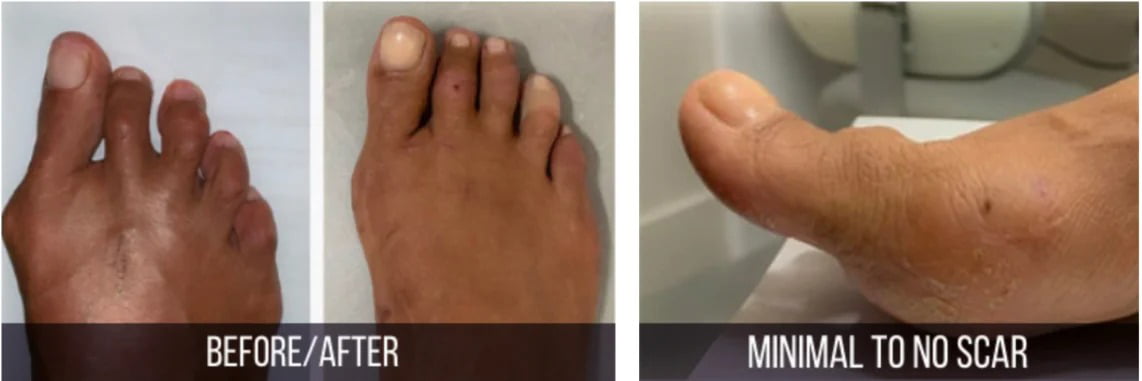
Before and After Bunion Surgery
In the pictures illustrated above, you can see the treatment results from patients who went through bunions New York treatment at our foot clinic. As you can see, the postoperative scar is barely visible when you get your removal procedure performed by the best bunion surgeon. The renowned foot doctor is highly trained in innovative, no scar surgical techniques and only uses the most advanced surgical equipment available in the USA.
Most foot surgeons make large incisions when performing traditional bunion surgery. But as you can see in the top picture on the right, there is minimal to no scar visible since we perform new bunion procedures using the latest techniques. Our Podiatrists specialize in performing the latest surgery for bunions that doesn’t alter the aesthetics of your foot.
See what our patients say…
★
★
★
★
★
He was incredible! He was one of the kindest doctors and had really amazing bedside manner. He saw me immediately (there was no wait) and I never felt rushed at all. He was very intelligent and skilled in helping me with my problem and was very reassuring to all of my concerns. I highly recommend him if you need a podiatrist! 🙂
HealthGrades
★
★
★
★
★
The doctor is courteous, professional, and to the point. He does not keep patients waiting and spends ample time with them. I have seen him several times for foot issues, and I have been satisfied each time with his skill in assessing and care for each patient.
zocdoc
★
★
★
★
★
Very down to earth! we agreed that bunion surgery minimally invasive was a good option for me. She and her team were efficient and scheduled me immediately. Knowing that I was in good hands put most of my post-surgery nerves at ease. It’s been 10 days since my surgery, and my foot is healing well. Very pleased that I chose her as my podiatrist!
zocdoc
Am I the Right Candidate?
Not every patient who has a bunion needs bunion removal surgery. Surgery is not the right option if you do not experience any pain. Even though the results of surgery can leave you with more attractive feet, it should not be performed solely for cosmetic purposes.
The following factors will be taken into consideration when deciding whether surgery is the right option:
- How bad the misalignment is
- The severity of your symptoms
- Whether your bunions are related to osteoarthritis
- Presence of underlying health conditions, such as diabetes, vascular disease, rheumatic disease, or nerve disorders
What Are My Bunion Surgery Options?
Because bunions range in size and shape, there are various types of surgical procedures (including minimally invasive) used to treat them. In most cases, surgery involves correcting the bone alignment and repairing the soft tissues around the big toe. Once our doctor evaluates your condition, they will determine the best type of bunion surgery for you.
Prior to committing to surgery, our bunion removal surgeons take enough time to meticulously examine the patients and measure the extent of the deformity and correction needed. Only then can they enact the successful outcomes they have always been known for.
Some of the most widely used types of bunion removal procedures are:
- Osteotomy. The surgeon makes small cuts in your big toe joint to realign it to a proper position. This will straighten the bone and improve the joint balance. This is often combined with soft tissue procedures to better maintain the big toe alignment.
- Exostectomy. The doctor removes the bunion bump from your toe joint without doing an alignment. Exostectomy by itself rarely corrects the cause of the problem and is usually just one part of the entire corrective surgery that includes osteotomy.
- Arthrodesis. In this procedure, the arthritic joint surfaces are removed and replaced with screws or metal plates until the bone heals to fix the deformity. This type of procedure is mainly used in severe cases or for patients with severe arthritis.
Bunions (Hallux Valgus) Deformity Stages
If symptoms of bunion is severe, surgery is the only effective treatment to relieve the pain. The most appropriate type of surgery depends on multiple factors, such as the extent of changes associated with bunion bump deformities as well as the bone changes and position of the bones in the foot. Our Podiatrists will explain the reasoning behind a particular decision in your specific case.
What Does Surgical Bunion Correction Entail?
Most bunion surgeries include removing the bump from the big toe joint and shifting the bone over. Our leading bunion surgeon does a minimal incision over the deformity to get an optimal cosmetic result. To prevent the deformity from returning, the bunions specialist typically moves the metatarsal bone over to prevent the re-occurrence of the bump.
Your podiatrist is surgically trained to correct this deformity and will guide you to the newest procedure, such as laser bunion surgery (aka non-invasive bunion removal), that suits your lifestyle and expectations. You will follow up with your local foot doctor every 1-2 weeks during your recovery to check the bone healing via x-rays.
What Should I Expect After Surgery?
You will have to keep your foot stable during the first few weeks after the procedure. Bandages and, in some cases, a splint might assist you in that. Our Podiatrists will provide you with detailed information on how to care for your foot at home following the surgical intervention for the first few weeks. Depending on the degree of your treatment, you may be discharged with a special surgical shoe or cast to aid in bunion recovery. Most patients report the postoperative pain as fairly tolerable when combined with medication and a dedicated program to relieve the discomfort.
Even though you can put pressure on your foot after surgery, but you should not be walking long distances. The extent to which you can put pressure on your foot depends on how painful it is and on the type of procedure you had. In general, the recovery time varies between 4-6 weeks. This is enough for your bones to become stable again. You will have follow-up appointments with your local foot doctor every 1-2 weeks during your recovery to check the bone healing via x-rays.
Our Podiatrists clearly realize the importance of the recovery stage. Hence, they are always on hand to support and guide you throughout the recovery process. By strictly following her recommendations, a swift and healthy recovery can be achieved
What Are the Potential Risks?
The safety of our patients has always been a top priority for our physicians and staff. Our Podiatrists perform the procedure under the most stringent safety protocols. However, every surgical intervention carries a certain degree of risk, and bunion removal is not an exception. Hence, all the potential risks and complications are communicated to the patient prior to surgery.
Some of the most common complications of bunion removal surgery are:
- Infected wound
- Death of bone tissues
- Higher risk of thrombosis
- Part of the toe can become permanently numb
- Inflammation, infection, and damage to blood vessels or nerves
- Osteoarthritis of the metatarsal bone
Bunionectomy is not recommended for patients who suffer from blood circulation problems. If you suffer from either diabetic foot or peripheral artery disease, surgery for bunion correction can cause wound-healing difficulties or the development of a chronic wound.
Once you’ve decided to go ahead with the no scar, minimally invasive bunion removal surgery, our podiatry doctor will discuss all the benefits, risks, and alternatives to surgical correction and answer any questions you may have.
The anesthesiologist will be present on the day of surgery and will review your medical history and labs as well as discuss the type of anesthesia you will be having.
How Long Does It Take to Recover From Bunion Surgery?
Following the foot surgery bunion removal, you will recover from anesthesia over a few hours. It is required to have someone pick you up after surgery. The first few days after surgery are typically the most painful, and your bunions doctor will prescribe you pain medication to alleviate those symptoms.
Contact your local bunion surgeon if you experience any of the following symptoms during your bunion surgery recovery period after being discharged:
- Chills
- Fever
- Warmth and redness in the area around the surgical dressing
- Increased pain in the area of the surgery
- Damp dressing that falls off
- Swelling above your foot, around your calf
- Soiled dressings
- Calf pain or cramping
When Can I Return to My Daily Activities After Bunion Removal?
After the procedure, you can expect a return to a normal lifestyle and activities in about six to eight weeks. Full bunion surgery recovery time can sometimes take longer, as you may experience swelling for up to six months after surgery.
Other factors that influence your recovery after minimally invasive bunion surgery include:
- The degree of your foot deformity
- The type of correction you received
- Your age and general health
- Compliance with surgical shoe and rest
Temper your expectations around the severity of your surgery. If your procedure was mild and your podiatrist only removed a small amount of bone and tissue, you can return to normal activity more quickly than if you had a more complex surgical intervention.
Our best podiatrist may prescribe a particular boot, shoe, or cast to be worn for several weeks after your bunion removal to give your foot added stability.
Once your surgical incision is healed, Our Podiatrists may suggest physical therapy and exercises that help strengthen your foot and get you to your normal life faster. These exercises improve your range of motion too. Adhering to the prescribed recovery regimen and following your surgeon’s post-operative instructions enable you to shorten your bunion foot surgery recovery time.
All symptoms, potential procedural/surgical options should always be discussed with your podiatrist near you or the best rated bunion surgery specialist after a thorough consultation and examination for an accurate diagnosis and treatment plan.
Published Data
Satisfaction
According to “The Treatment of Hallux Valgus” study published on PubMed: “Analysis of a large number of retrospective studies with follow-up for up to 5 years shows that overall, 85% of patients are satisfied and have a good clinical result. Ten percent are less satisfied and show a less beneficial outcome, and in 5% the results of surgery are poor.”
Statistics
According to “Prevalence of hallux valgus in the general population: a systematic review and meta-analysis” group study published on PubMed: Out of 496,957 participants grouped for meta-analysis, bunions (hallux valgus) were in:
- 23% in adults aged 18-65 years
- 35.7% in elderly people aged over 65 years
- females to male ratio 30% to 13%
According to “Adolescent hallux valgus: a systematic review of outcomes following surgery” study, out of 201 corrective osteotomies (129 females / 13 males):
- 2% cases of infections
- 11.9% cases of post-operative pain
- 4.5% scar hypersensitivity
Frequently Asked Questions
Is Bunion Treatment Painful?
Bunionectomy surgery performed in our foot clinic is painless since ankle block anesthesia is used during the procedure. The majority of bunion surgeries are performed under local anesthesia with intravenous sedation. This results in your foot being completely numb during the procedure, and you will also be given medications that help you relax. However, once the anesthesia wears off, you will feel some moderate pain for the next few days following the procedure.
Your pain may be slightly increased post-operatively for a few days. The amount of pain felt after bunionectomy will differ from one patient to the next. You can minimize the pain and swelling by closely following the after-care advice given to you by your bunion surgery doctor who may also prescribe medications to ease your discomfort.
The given instructions from the podiatrist nearby will provide detailed information about how to care for your foot at home following the surgery for the first few weeks. Depending on the degree of your bunion treatment, you may be discharged with a special surgical shoe or cast to aid in bunion recovery. Most patients report the postoperative pain as fairly tolerable when combined with medication and a dedicated program to relieve the discomfort.
How Much Is Bunion Surgery?
There are more than 40 different types of foot bunion surgery. Therefore, the cost can vary greatly. According to recent studies, the average bunion surgery cost is approximately $5,600. However, it can range from $3,500 up to $12,000. Complex procedures require large corrections, thus, more surgical hardware is needed. As a result, the bunion surgery price will increase.
Other factors influencing the total fee are:
- Your geographic location
- Experience of the surgeon
- Surgical center
Before undergoing any kind of treatment, make sure to determine the final cost of the procedure. You can always contact our clinic and get detailed information about current prices.
Is Bunion Surgery Covered by Insurance?
Insurance companies consider foot bunion surgery as a medically necessary procedure; therefore, you can expect partial or even total costs to be covered. However, you should keep in mind that if a bunion is small and causes no pain, your insurance provider might not cover the procedure. The type of insurance plan highly impacts the cost of the procedure. You can always get in contact with your insurance company and ask whether this type of procedure is covered by your insurance plan.
Important Reminder: This information is only intended to provide guidance, not definitive medical advice. Please consult our leading bunion surgeon about your specific condition. Only a trained, experienced board certified podiatrist or bunion specialist can determine an accurate diagnosis and proper treatment.
Do you have any questions about the no-scar bunion surgery procedure? You can finally stop searching for “bunion surgery near me” and schedule an appointment with an internationally recognized, top-rated bunion surgeon in NYC at Manhattan Foot Specialists. Do not wait any longer and contact our office for a consultation.






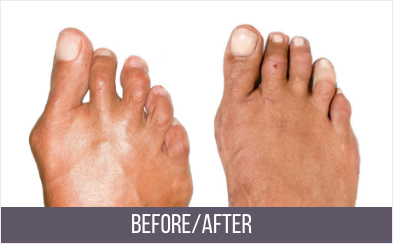
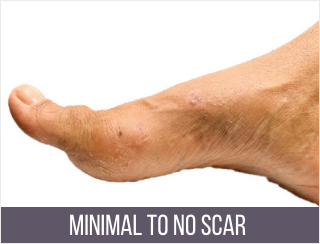
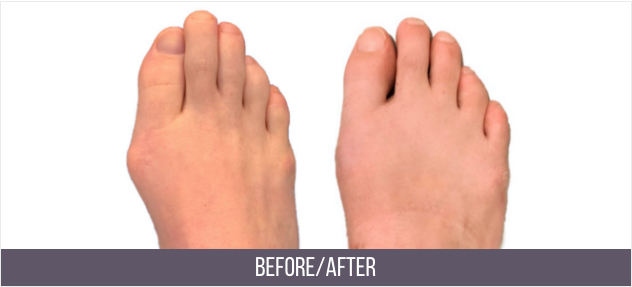
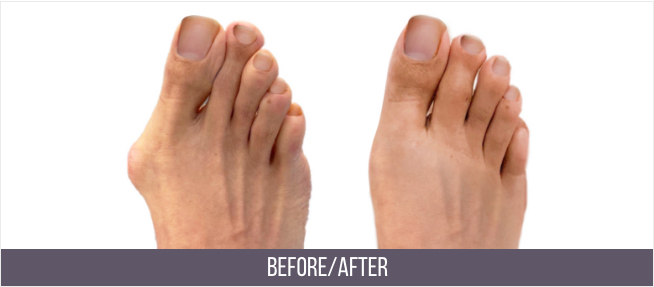
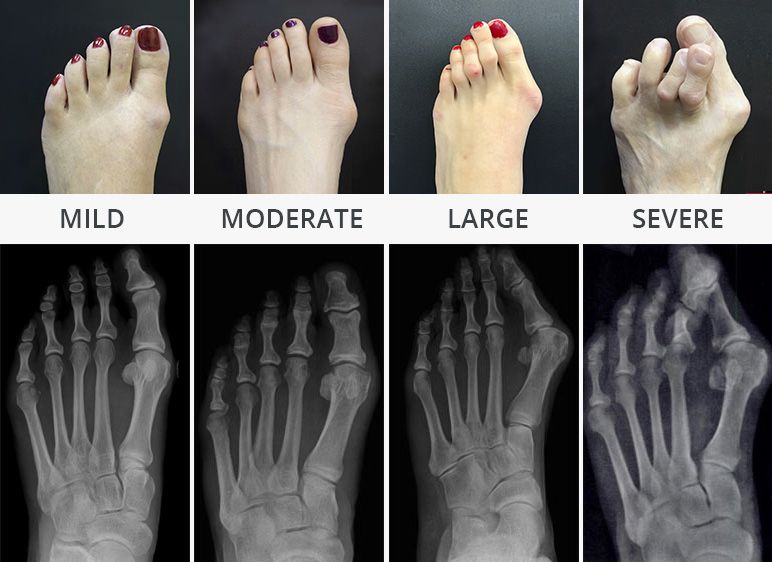 If symptoms of bunion is severe, surgery is the only effective treatment to relieve the pain. The most appropriate type of surgery depends on multiple factors, such as the extent of changes associated with bunion bump deformities as well as the bone changes and position of the bones in the foot. Our Podiatrists will explain the reasoning behind a particular decision in your specific case.
If symptoms of bunion is severe, surgery is the only effective treatment to relieve the pain. The most appropriate type of surgery depends on multiple factors, such as the extent of changes associated with bunion bump deformities as well as the bone changes and position of the bones in the foot. Our Podiatrists will explain the reasoning behind a particular decision in your specific case.